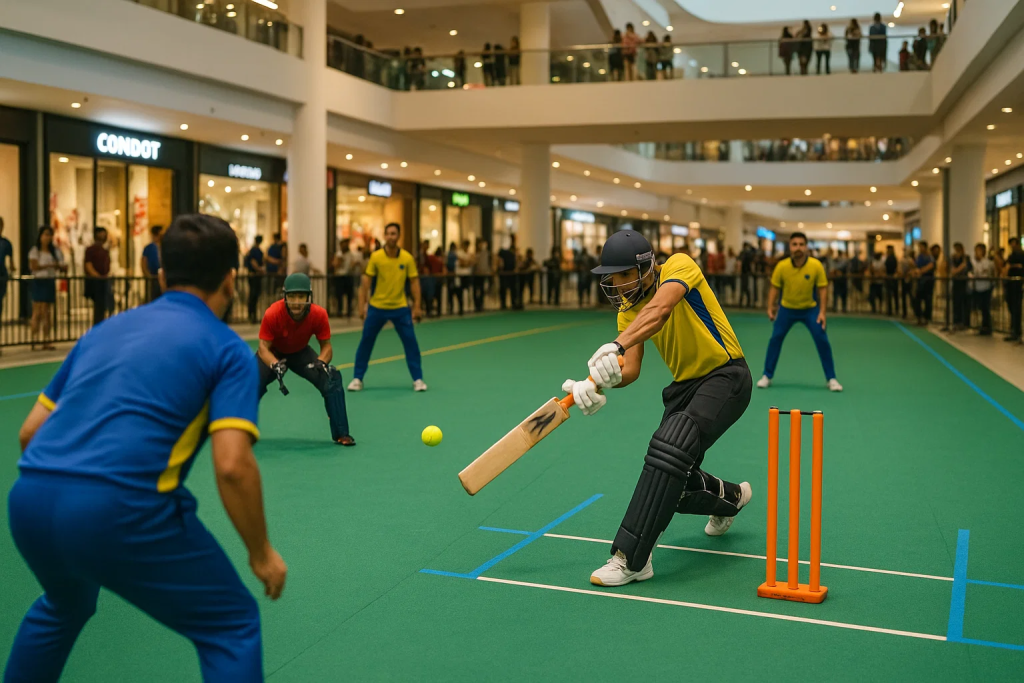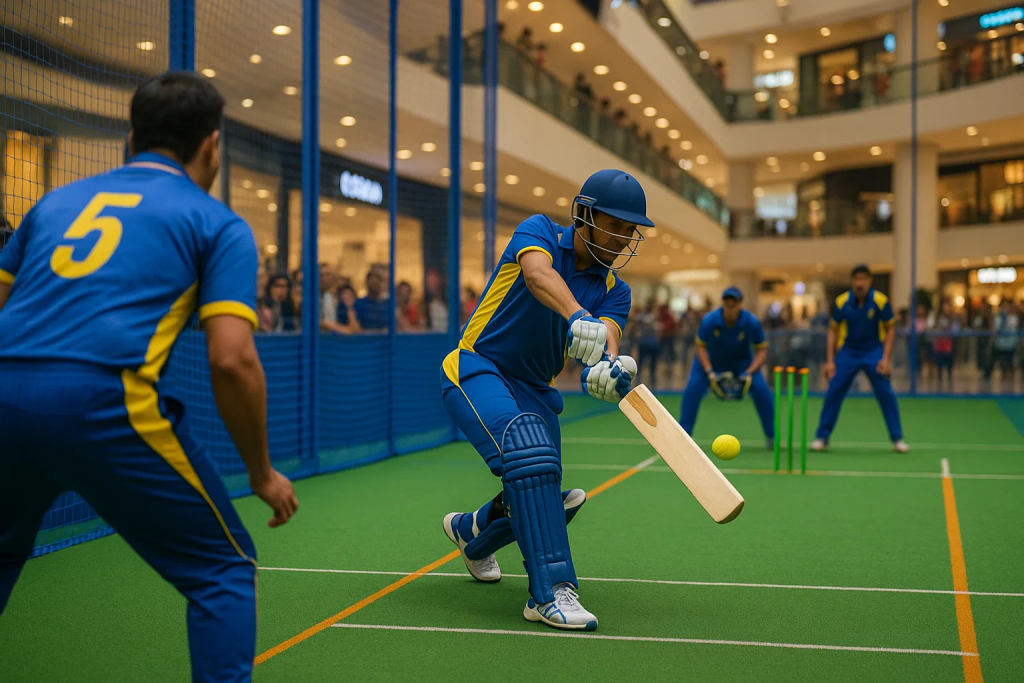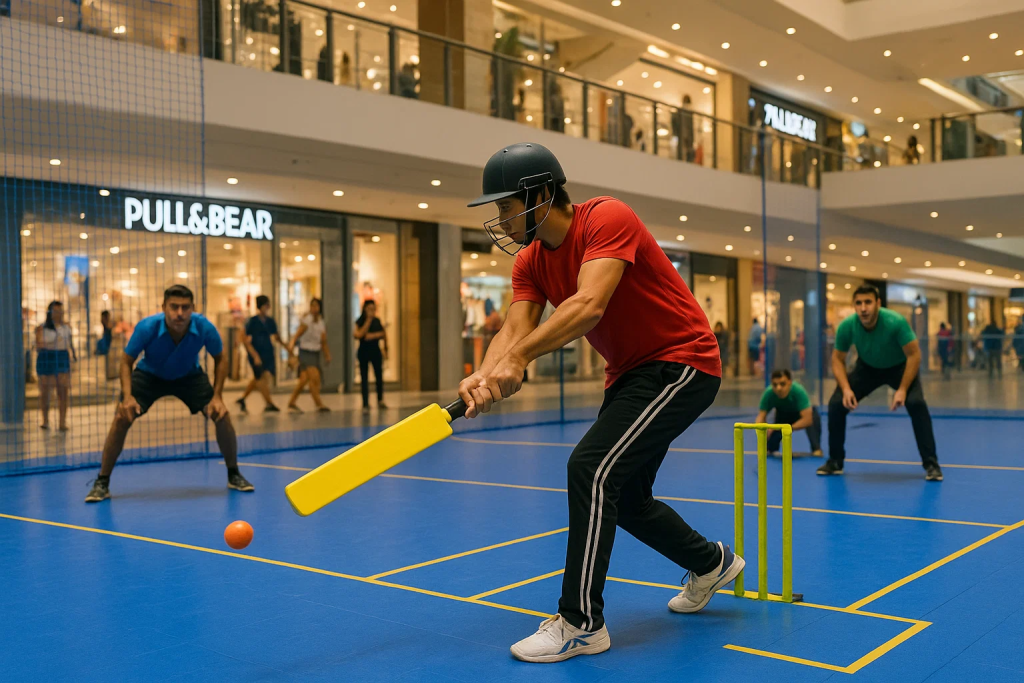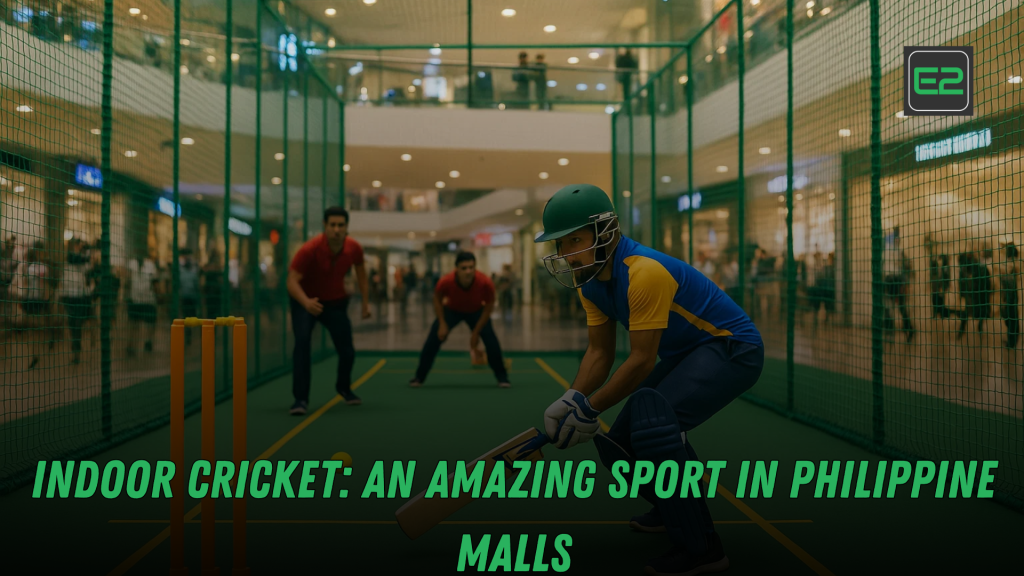Table of Contents
Why Indoor Cricket Fits the Philippine Mall Lifestyle
This comprehensive guide explains what indoor cricket is, how it works inside a mall, the benefits for players and operators, program ideas, cost and safety basics, and everything you need to start playing or organizing. Whether you’re a parent, student, HR lead, mall operator, or just curious, you’ll walk away with a complete playbook.
If there’s a single place where Filipinos come together every day, it’s the mall. From groceries and cinemas to co-working pods and clinics, malls have evolved into community hubs. Now they’re adding something new: indoor cricket—a fast, social, and space-efficient sport that thrives in climate-controlled venues. Shorter than traditional matches, friendlier for beginners, and built for group laughs and quick wins, indoor cricket can be your weekend fitness habit, a corporate team-building staple, or a youth development pathway.

What Is Indoor Cricket? (And How It Differs from Outdoor Cricket)
Indoor cricket is a modified version of cricket designed for small, net-enclosed courts with shorter formats and continuous action. While rules vary by venue, the core idea is consistent: keep games under 60 minutes, make participation easy, and maintain the essence of batting, bowling, and fielding.
Key differences vs traditional cricket:
- Venue: Enclosed court with tensioned nets; balls remain in play off the nets for fast rallies.
- Team size: Commonly 6–8 players per side, allowing quick rotations and easier team formation.
- Game length: Typically 30–60 minutes—perfect for mall schedules and after-work sessions.
- Scoring: Encourages aggressive running and inventive shots; hitting nets can yield bonus runs.
- Inclusivity: Rulesets often include mixed-gender and all-ages brackets; easier entry for beginners.
- Equipment: Softer balls and lightweight bats lower the intimidation factor and reduce injury risk.
Why Filipinos will love it: If you enjoy basketball’s speed, badminton’s reflexes, and volleyball’s team spirit, indoor cricket blends elements of all three: explosive moves, smart positioning, and clear roles for every skill level.
Why Cricket in Malls? Climate, Convenience, and Community
1) Climate-controlled comfort: Tropical heat, sudden rain, and typhoons can derail outdoor play. Indoor cricket removes weather as a variable, delivering consistent experiences.
2) Convenience culture: Malls already host parking, food courts, restrooms, pharmacies, and first-aid stations—all the amenities you need before or after a game.
3) Time-boxed fun: Short formats pair perfectly with lunch breaks, after-work play, and weekend family trips.
4) Social magnet: With spectator zones and glass panels, games are easy to watch, cheer, and livestream—great for community buzz and mall foot traffic.
5) Safety and supervision: Enclosed courts, standardized equipment, and trained staff offer safe, structured play suitable for children and beginners.
Benefits for Players, Parents, Schools, and Companies
For players
- Cardio + Coordination: Sprinting between wickets, tracking rebounds off nets, reactive catching.
- Skill variety: Everyone bats, bowls, and fields—faster learning vs single-position sports.
- Quick progress: Frequent touches and short innings keep learning curves steep and satisfying.
- Low barrier: Softer balls and smaller courts reduce intimidation and make it fun from Day 1.
For parents and schools
- Character-building: Teaches teamwork, rotation, accountability, and decision-making.
- Year-round program: Zero rainouts equals reliable scheduling for kids’ routines.
- Academic synergy: Scoring, angles, and timing build math and spatial reasoning.
For HR and corporate wellness
- True team sport: Requires coordination and communication—ideal for team-building.
- Time efficient: 45–60 minute matches fit after-work or lunch slots.
- Inclusive: Leagues can accommodate mixed skill and mixed gender teams.
For mall operators
- Foot traffic: Sports draw repeat visits, expand dayparts, and lift F&B spend.
- Differentiation: A novel, Instagrammable activity that keeps tenants happy and attracts new ones.
- Program revenue: Memberships, lessons, leagues, birthday parties, and corporate bookings.
The Court, Equipment, and Basic Rules (Mall-Friendly Edition)
Court & Nets
- Rectangular court enclosed by nets; a pitch lane in the middle for batting and bowling.
- Marked zones on side nets award bonus runs when hit by the ball.
- Spectator viewing via clear panels; benches and safe entry/exit zones.
Equipment
- Indoor cricket bat: Lightweight, forgiving sweet spot.
- Indoor ball: Softer core, textured for grip; bright color for visibility.
- Wickets: Lightweight stumps with rubber bases; optional LED bails for visual flair.
- Protective gear: Batting gloves, optional forearm/leg guards; helmets for youth fast bowling.
- Footwear: Non-marking indoor shoes with side support.
Basic Play Flow
- Each team bats and bowls for a set number of overs (e.g., 8–12 overs total).
- Batters score by running between wickets and hitting net zones.
- Fielders use nets to their advantage: rebounds create creative run-outs and catches.
- Dismissals (bowled, caught, run out) reduce batting side’s tally or end a pair’s turn, depending on ruleset.
- Rotation ensures everyone participates—perfect for kids and newcomers.
Program Models That Work in Philippine Malls
1) Learn-to-Play Clinics (Kids & Adults)
Weekly 60-minute classes: warm-up, skill drill, mini-game. Offer 8-week cycles with badges (Beginner, Intermediate, Advanced).
2) After-School & Weekend Youth Leagues
Age brackets (U9, U12, U15, U18) with short seasons (6–8 weeks), inclusive formats, and “buddy umpire” sessions to build leadership.
3) Corporate Team-Building & Friendly Cups
One-day round-robins for companies. Add skills challenges (accuracy bowling, boundary target hitting) for variety.
4) Family Doubles / Mixed Social Nights
Pairs format (parent-child, siblings, friends). Emphasize fun scoring and themed nights (retro jerseys, neon nights).
5) Birthday Parties & Celebrations
2-hour package: coach-led mini-games, photo ops, cupcakes from mall tenant partners. Low-stress, high-delight.
6) Skill Ladders & Open Play
Drop-in slots with matchmaking by skill. Weekly ladder rankings to reward consistency without the pressure of full league play.
Safety, Accessibility, and Inclusivity
- Age-appropriate balls and bowling speeds; helmets for youth when facing faster deliveries.
- Pre-game warm-ups and post-game cooldowns to reduce strains.
- Clear net rules to avoid entanglement and dangerous collisions.
- Inclusive brackets: “New to Sport,” “Mixed Social,” “Women’s,” “Masters (40+).”
- Accessibility: Ramp access, seating for spectators with mobility needs, flexible session lengths.
Costs and Budgeting (Player & Organizer Perspective)
For players/families (indicative, varies by venue):
- Starter pack: Indoor bat or shared rental, gloves, non-marking shoes, water bottle.
- Session fees: Learn-to-play classes, open play, or league dues.
- Optional: Personal helmet for youth, custom grips, jersey.
For mall operators/venue partners:
- Capex: Modular court, netting, padding, LED scoreboards, camera mounts, benches.
- Opex: Coaching staff, referees, cleaning, scheduling software, marketing, insurance.
- Revenue streams: Memberships, bookings, leagues, parties, corporate events, concessions, merchandise, sponsorships.
Tip: Use found space such as under-utilized event halls or long corridors. Modular courts can be installed, moved, and re-skinned seasonally to keep novelty high.

Training the Filipino Beginner: A 6-Week On-Ramp
Week 1: Bat swing basics, grip, stance; gentle underarm bowling; rules walkthrough.
Week 2: Bowling lines & lengths with targets; catching off net rebounds; running between wickets.
Week 3: Shot selection—deflects to side nets, drives down the lane; safe calling for runs.
Week 4: Fielding drills—relay throws, quick pickups; wicket-keeper fundamentals.
Week 5: Mini-matches with simplified overs; introduce strategic placement.
Week 6: Scrimmage night; hand out progress badges; invite to social league.
Coaching Notes for Multi-Sport Filipinos
Many Filipinos arrive with basketball, volleyball, or badminton skills. Leverage them:
- Basketball → cricket: use lateral slides and box-out instincts for fielding angles.
- Volleyball → cricket: transfer setting/cushioning hands to soft catches; serving rhythm to bowling run-up.
- Badminton → cricket: footwork economy and split-step timing help with reactive fielding and batting balance.
Gamifying the Experience (Because We Love Leaderboards)
- Hit Streaks: Reward players who chain successful shots/deflections.
- Accuracy Rings: Bowling targets with progressive points.
- Shot Bingo: Fill a 3×3 card (e.g., “score via left net,” “two-run sprint”).
- Season Quests: “Play 5 weeks in a row,” “Teach a friend the basics,” “Volunteer umpire once.”
Content & Community: Make It Instagrammable
- Highlight Reels: Short clips of great catches and funny mishits (with consent).
- Photo Frames: Branded backdrops for winning pairs/teams.
- Theme Nights: Jersey swaps, neon nights, “Pinoy icons” uniforms.
- Mall Tie-ins: Discounts from food tenants for players who show same-day booking QR.
Scheduling That Works for Philippine Malls
- Weekdays: 5:30–9:30 PM (after work and school).
- Weekends: 10 AM–9 PM (family and leagues).
- Micro-slots: 45-minute bookings to maximize turnover and availability.
- Blockers: Keep buffer times for cleaning, turnover, and quick net checks.
Operations: Staff, Software, and Service
- Staffing: 1–2 coaches per court block, trained in first aid; floating umpire for league nights.
- Software: Booking app with waitlists, skill tags, league standings, and wallet.
- Service: Water refill station, towel rentals, small pro-shop (grips, gloves, jerseys).
Sustainability and Sound Management
- Acoustics: Acoustic panels and curtain baffles to keep noise mall-friendly.
- Flooring: Non-marking, shock-absorbent tiles; easy to clean and maintain.
- Lighting: LED with high CRI for visibility and better photos.
- Materials: Durable, recyclable netting; modular pieces with long service life.
Tournament Blueprints: From Weekend Cup to City Series
One-Day Cup:
- 8 teams, two pools, top two advance to semis and finals.
- Skills intermission for spectators (accuracy throws, radar gun bowling).
City Series (4–6 weeks):
- Round-robin groups → knockout finals.
- MVP, Best Bowler, Best Fielder, Rising Star awards.
Youth Festival:
- Short matches with coach-referees; parent-child exhibition; award badges for effort and sportsmanship.
Health & Safety Checklist (Mall Edition)
- Pre-game dynamic warm-up; post-game stretch and hydration.
- Youth helmets for faster bowling; protective pads as needed.
- Court inspections for net tension, anchor safety, clear entryways.
- First-aid kit and AED access; staff certified in basic life support.
- Clear signage: rules, emergency exits, and contact point.
For Mall Operators: A Simple P&L Frame
- Capex: Court kit, nets, flooring, storage, scoreboards, benches, brand visuals.
- Opex: Salaries, utilities, cleaning, insurance, software, marketing.
- Revenue: Bookings (retail + corporate), memberships, leagues, parties, camps, merchandise, sponsorships.
- KPIs: Court utilization %, revenue/hr, cost per acquisition, retention rate, average sessions/player, F&B uplift with partner tenants.
The Cultural Fit: Why This Can Become a Pinoy Staple
- Team-centric: Like basketball and volleyball, indoor cricket celebrates group play.
- Short & sweet: Matches fit between errands, Mass, or movies—perfect for family days.
- Shareable: Big catches and quick run-outs make viral-ready clips.
- Accessible: Beginners feel included; experts can still flex skills in advanced divisions.
Step-by-Step: How to Start Playing This Week
- Grab friends or officemates (6–8 players).
- Book a trial session (45–60 minutes).
- Borrow gear first; buy later if you fall in love.
- Take a learn-to-play class to master basics fast.
- Join a social night or mixed league to build consistency.
Call to Action
Ready to try something new that fits your schedule and your barkada?
Gather 6–8 friends, book a one-hour slot at the nearest mall-based indoor cricket venue, and experience the rush of batting, bowling, and crazy net rebounds—without the heat or rain. Ask about learn-to-play, family nights, or corporate cups. One session is all it takes to turn curiosity into a weekly habit.
Final Words
Indoor cricket adapts traditional cricket for net-enclosed, mall-friendly courts, compressing matches into 30–60 minutes with 6–8 players a side and softer balls for safety and accessibility. Nets keep the ball in play, enable creative rebounds, and award bonus runs via marked zones, producing constant action that’s easy for beginners yet satisfying for skilled players.
PH Boxing Federations Merge: What It Means for the Amazing Athletes
Why malls? Climate-controlled venues eliminate rain and heat, align with the Philippine habit of spending weekends in malls, and leverage built-in amenities (parking, F&B, first aid). Short formats fit after-school and after-work schedules, while spectator-friendly glass panels turn games into shareable, foot-traffic-driving events.
Benefits across audiences:
- Players: Cardio, coordination, fast learning curves, and equal chances to bat, bowl, and field.
- Parents/Schools: Year-round reliability, teamwork and decision-making, math/spatial learning via scoring and angles.
- Companies/HR: Time-efficient team-building with inclusive mixed-skill leagues.
- Mall operators: Differentiation, repeat visits, F&B uplift, and diversified revenue (clinics, leagues, parties, corporate cups).
Court, gear, rules: A compact pitch lane sits inside tensioned nets; lightweight bats, bright soft balls, and rubber-based wickets reduce risk. Matches rotate all players; dismissals (bowled, caught, run-out) apply with simplified scoring to keep play moving.

Programs that work: Learn-to-play clinics, youth leagues (U9–U18), corporate round-robins, family/mixed social nights, birthday packages, open play with ladder rankings. A 6-week beginner ramp builds from grip/stance and gentle bowling to mini-matches and scrimmage.
Safety & inclusivity: Age-appropriate speeds, youth helmets for faster bowling, warm-up/cooldown protocols, clear net rules, and brackets like Women’s, Mixed Social, and Masters (40+). Accessibility features (ramps, seating) and flexible session lengths welcome more participants.
Costs & ops: Players start with non-marking shoes, gloves, and optional rentals; venues invest in modular courts, nets, LED scoring, and coaching staff. Revenues come from memberships, bookings, leagues, parties, merch, and sponsorships. Scheduling sweet spots: weekdays 5:30–9:30 PM, weekends 10 AM–9 PM, using 45-minute slots with cleaning buffers.
Community & content: Leaderboards, skills challenges, theme nights, mall tenant tie-ins, highlight reels, and branded photo backdrops fuel social buzz. Acoustics, shock-absorbent flooring, and LED lighting keep the experience comfortable and camera-ready.
Cultural fit & next steps: Team-centric, short, and social, indoor cricket aligns with Filipino leisure habits. Gather 6–8 friends, book a one-hour trial, borrow gear, take a clinic, then join a social league. With clear rules, strong safety, and lively programming, indoor cricket can become a family-friendly, year-round staple of Philippine mall life.
Frequently Asked Questions (FAQ)
1) Do I need cricket experience to play?
No. Indoor cricket is designed for beginners. Venues provide starter clinics, coach-led sessions, and social leagues with simplified rules. You’ll bat, bowl, and field within your first hour.
2) What should I wear and bring?
Wear breathable sportswear, non-marking indoor shoes, and bring water. Gloves help grip, and youth players may use helmets for faster bowling. Most venues rent or lend gear if you don’t have equipment.
3) How long does a match take and how many players are needed?
Most matches finish in 45–60 minutes. Teams usually have 6–8 players, with rotating roles so everyone bats and bowls.
4) Is it safe for kids and older adults?
Yes—formats use softer balls, smaller courts, and age-appropriate speeds. Coaches supervise play, and rules emphasize safe footwork and fair conduct. Always warm up and follow staff guidance.
5) How do I form or join a league?
Ask the venue about open play, matchmaking for individuals, or corporate divisions. Many malls run seasonal ladders and mixed social leagues—sign up, list your skill level, and they’ll place you on a team.
